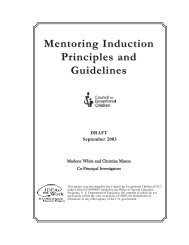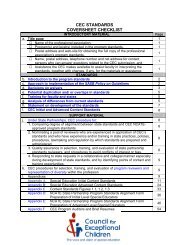What Every Must Know Special Educator - Council for Exceptional ...
What Every Must Know Special Educator - Council for Exceptional ...
What Every Must Know Special Educator - Council for Exceptional ...
You also want an ePaper? Increase the reach of your titles
YUMPU automatically turns print PDFs into web optimized ePapers that Google loves.
Paragraph 3 - Administrative Hierarchy<br />
<strong>Every</strong> school system should contain a visible central<br />
administrative unit <strong>for</strong> special education programs<br />
and services which is at the same administrative hierarchical<br />
level as other major instructional program<br />
units.<br />
The parameters of regular and special education<br />
should be articulated so that children may be af<strong>for</strong>ded<br />
equal educational opportunity through the resources<br />
of either or both instructional programs.<br />
Such articulation should be achieved through sensitive<br />
negotiations between the responsible agents of<br />
both regular and special education who meet in full<br />
parity. To protect the rights of all children to equal<br />
educational opportunity, the policy-making bodies of<br />
school systems should include administrators of both<br />
regular and special education.<br />
Programs to meet the needs of children with exceptionalities<br />
are no less important than those designed<br />
to meet the needs of other children. The importance of<br />
programs to meet human needs should not be judged<br />
on the basis of the number of clients the programs are<br />
expected to serve.<br />
Paragraph 4 - <strong>Special</strong> Education<br />
and School Budgets<br />
Success of all education programs is dependent on the<br />
provision of adequate funding. This is essentially true<br />
of programs <strong>for</strong> children and youth with exceptionalities.<br />
Often funding <strong>for</strong> such programs becomes buried<br />
in general budgeting procedures. In such cases, children<br />
and youth with exceptionalities do not have the<br />
opportunity to have their needs directly considered by<br />
the decision-making bodies of government. There<strong>for</strong>e,<br />
The <strong>Council</strong> urges that ef<strong>for</strong>ts be undertaken to assure<br />
that budgetary provisions <strong>for</strong> children and youth with<br />
exceptionalities be clearly identified. The <strong>Council</strong><br />
opposes general funding procedures that would circumvent<br />
direct aid to programs <strong>for</strong> children and youth<br />
with exceptionalities.<br />
Since children with exceptionalities have the same<br />
rights to education as other children, the educational<br />
needs of children with exceptionalities cannot be<br />
delayed until the needs and service demands of the<br />
majority of children have been satisfied. Educational<br />
resources are always likely to be finite. The application<br />
of the principle of “the greatest good <strong>for</strong> the<br />
greatest number” to determine which children’s needs<br />
shall be met first directly contradicts our democratic<br />
society’s declared commitment to equal educational<br />
opportunity <strong>for</strong> all children. History confirms that the<br />
266 whAt every SpeCiAl eduCAtor muSt <strong>Know</strong><br />
social injustices and ill effects that flow from the application<br />
of the majority-first principle to educational<br />
budgeting are too serious <strong>for</strong> this principle to be used<br />
in educational financing.<br />
Children with exceptionalities constitute a minority<br />
of the school population. The programs serving them<br />
represent a comparatively high financial investment in<br />
relation to the numbers of children served. In some<br />
school systems, money allocated to special education<br />
is regarded as an alternative to the improvement of<br />
regular school programs. The climate of competitive<br />
interests thus produced can jeopardize the stability of<br />
special education services.<br />
The interests of the community are ill served if competition<br />
<strong>for</strong> funds is conducted on the basis of special<br />
interests. <strong>What</strong> is needed, rather, is the cooperation<br />
of both regular and special educators to educate the<br />
public in the desirability of meeting the needs of all<br />
children without discrimination or favoritism.<br />
There is every reason to believe that the public interest<br />
is best protected when the responsibility <strong>for</strong> the<br />
deployment of public resources is placed in the hands<br />
of persons who are qualified by training and experience<br />
to make the necessary judgments. Thus, special<br />
education should play an active role in determining<br />
how resources are to be allocated. However, the community<br />
has the ultimate responsibility to determine<br />
goals and to evaluate per<strong>for</strong>mance.<br />
Resources should be allocated to special education on<br />
the basis of programs to be provided, not on the basis<br />
of traditional categorical incidence estimates.<br />
The mandate to provide all children with equal<br />
educational opportunities requires that all educators,<br />
whether regular or special, be equally concerned with<br />
the funding of both regular and special education<br />
programs. No school system can fulfill the mandate<br />
if rivalries <strong>for</strong> dollars are permitted to supersede the<br />
needs of children.<br />
ChAPTER 05<br />
SPECIAL EDuCATION AND ThE COMMu-<br />
NITY OuTSIDE ThE EDuCATION SYSTEM<br />
Paragraph 1 - Liaison with Other<br />
Agencies and Organizations<br />
Children and youth with exceptionalities and their<br />
families require the services of many agencies which<br />
deal with their various needs. In most cases, individual<br />
agency ef<strong>for</strong>ts can be made more effective through a cooperative<br />
interagency and interdisciplinary approach









